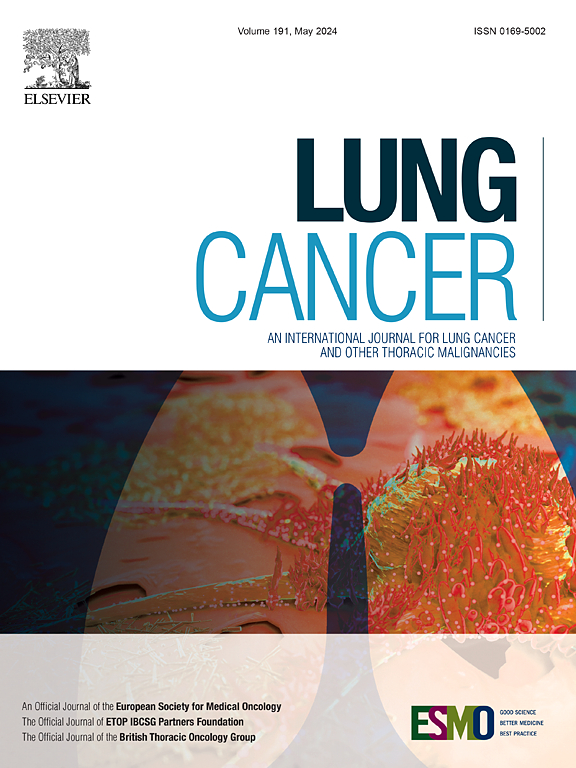Association of lung silica deposition with epidermal growth factor receptor-mutant lung cancer
IF 4.4
2区 医学
Q1 ONCOLOGY
引用次数: 0
Abstract
Background
Exposure to particulate matter ≤2.5 μm (PM2.5), which comprises various components, has been implicated in epidermal growth factor receptor (EGFR)-driven lung cancer development. The silica can be inhaled non-occupationally as PM2.5, particularly that derived from Asian dust in East Asia.
Methods
This retrospective cross-sectional study investigated consecutive patients with surgically resected lung adenocarcinoma tested for EGFR mutations during 2020–2022. Silica particles in the resected lungs were counted via polarized light microscopy. Patients were categorized into high- and low-silica groups according to the cutoff value of the number of silica deposits. We conducted receiver operating characteristic curve analysis for EGFR mutation status according to silica deposit levels. We compared EGFR mutation profiles and performed logistic regression model analysis.
Results
Of the 174 patients, only three had an occupational silica-exposure history. The median numbers of silica deposits in 20 microscopic fields-of-view were 26.0 and 9.0 particles in patients with and without EGFR mutations, respectively (P < 0.001). EGFR mutations occurred in 66.7 % and 30.4 % of participants in the high- (n = 72) and low-silica groups (n = 102), respectively (P < 0.001). The Cochran–Armitage trend test showed a significant linear trend for higher silica deposition with a higher prevalence of EGFR mutations (P < 0.001). Multivariate analysis revealed that high silica deposition was independently associated with EGFR mutations (adjusted odds ratio, 3.20; 95 % confidence interval, 1.49–6.88; P = 0.003).
Conclusion
Silica can be deposited in the lungs even without occupational exposure and is associated with EGFR-mutant lung adenocarcinoma.
肺二氧化硅沉积与表皮生长因子受体突变型肺癌的关系。
背景:暴露于≤2.5 μm (PM2.5)的多种成分的颗粒物中,与表皮生长因子受体(EGFR)驱动的肺癌发展有关。二氧化硅可以作为PM2.5被非职业吸入,特别是来自东亚的亚洲粉尘。方法:这项回顾性横断面研究调查了在2020-2022年期间进行EGFR突变检测的连续手术切除肺腺癌患者。通过偏振光显微镜对切除肺内的二氧化硅颗粒进行计数。根据二氧化硅沉积数量的临界值将患者分为高硅组和低硅组。我们根据二氧化硅沉积水平对EGFR突变状态进行了接受者工作特征曲线分析。我们比较了EGFR突变谱并进行了逻辑回归模型分析。结果:174例患者中,仅有3例有职业性二氧化硅暴露史。EGFR突变患者和非EGFR突变患者在20个显微镜视野中二氧化硅沉积的中位数分别为26.0和9.0颗粒(P结论:即使没有职业暴露,二氧化硅也可以沉积在肺部,并与EGFR突变肺腺癌有关。
本文章由计算机程序翻译,如有差异,请以英文原文为准。
求助全文
约1分钟内获得全文
求助全文
来源期刊

Lung Cancer
医学-呼吸系统
CiteScore
9.40
自引率
3.80%
发文量
407
审稿时长
25 days
期刊介绍:
Lung Cancer is an international publication covering the clinical, translational and basic science of malignancies of the lung and chest region.Original research articles, early reports, review articles, editorials and correspondence covering the prevention, epidemiology and etiology, basic biology, pathology, clinical assessment, surgery, chemotherapy, radiotherapy, combined treatment modalities, other treatment modalities and outcomes of lung cancer are welcome.
 求助内容:
求助内容: 应助结果提醒方式:
应助结果提醒方式:


